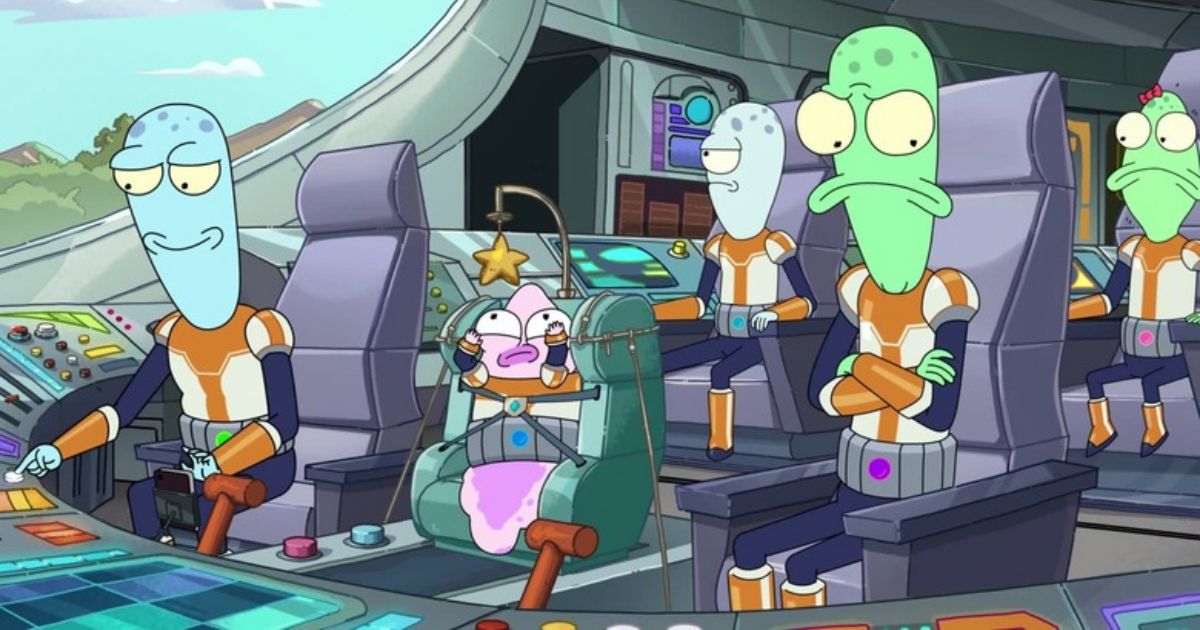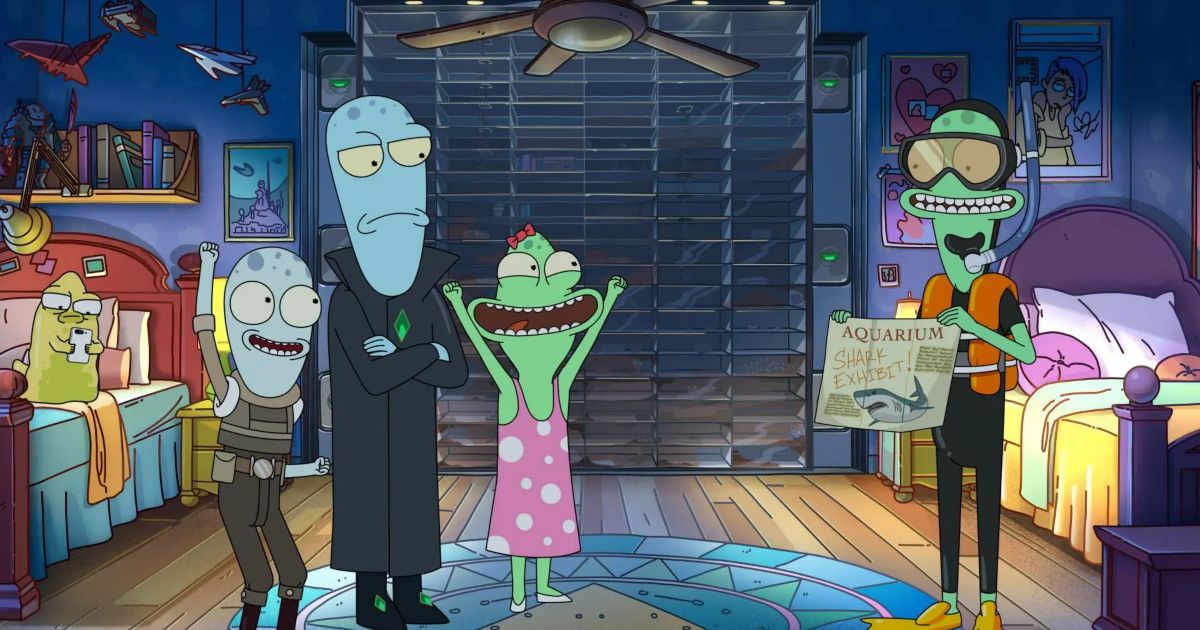Solar Opposites follows a group of aliens who have crash-landed atop a decent suburban home on Earth after their planet Shlorp was destroyed by an asteroid. These four Shlorpians are just doing the best they can in a pickle, raising a cute little planet-devouring slug (the Pupa) who will eventually terraform Earth, killing all humans and recreating Shlorp; in the meantime, boy do these rascals get into some wacky shenanigans.
Solar Opposites takes its own ridiculous premise and the inherent oddness of sci-fi and fuses it with the assembly line-style simulacra of ’90s family sitcoms into what is actually one of the most purely enjoyable and fun TV shows around right now. Part of that is because the Hulu series (which broke records in its first season) simply disregards the kind of logistics and complications that other shows obsess over; Solar Opposites is the kind of show that cuts out exhaustive exposition in order to get to the good stuff.
For example, the characters have ray guns for everything — to make you small, smart, dumb, fast, a gargoyle, a special holiday decoration, literate, a rat (not to be confused with the R.A.T. ray, or the Rad Awesome Terrific ray, which makes you super cool), or just about anything else that can move the plot along. The point is, Solar Opposites cares more about having a good time than almost anything else, and it continues to do so in the wonderful season three. The show’s cast and crew sat down with MovieWeb to discuss its success and trajectory.
The Cast, Creators, and Characters of Solar Opposites
The creators and producers have a wonderful pedigree of comedy that should indicate the kind of style of Solar Opposites — Justin Roiland is famous for Rick & Morty (though his earlier work like the drastically different House of Cosbys and Fish Hooks shouldn’t be ignored), Mike McMahan worked on Rick & Morty episodes with him (while also responsible for the underrated Lower Decks), and Josh Brycel brings his comedy experience as a writer and producer on Happy Endings, Scrubs, American Dad, and many more. They all teamed with some incredible comic actors (Sean Giambrone, Mary Mack, Thomas Middleditch, and more) to bring the animation to life.
Despite its anarchic silliness, this deliriously delightful show is actually very well plotted, with little moments building on themselves over time to create startling surprises. “When we go into a season, we map out what’s going to go where,” McMahan says, and that is certainly evident in the way the show has developed throughout three seasons. The Solar Opposites ‘family’ is less a ‘traditional’ family at first; there doesn’t seem to be any strong biological ties between them (although they are a plant species), and none of them chose to be with each other.
The laid-back dingus Terry is the Pupa specialist, the strict and intelligent Korvo works on the ship; their ‘replicants’ who assist them include the impulsive and violent Yumyulack as their security guard, and the sweet but naive Jesse as their historian. None of them really do their jobs though, having been almost totally assimilated into American culture, and the series tracks that push and pull between their Shlorpian nature and their growing interest in Earth. It also chronicles their development as an actual family, one which stops trying to literally kill each other and comes together as Terry and Korvo become like husbands to each other and father figures to Yumyulack and Jesse.
The Growing Family (and Frisky) Bonds of Solar Opposites
“That definitely wasn’t part of it from the start,” Middleditch says, “it was kind of like a happy discovery.” The evolution of Terry and Korvo’s relationship over the seasons has been one of the delights of the show, and watching them have lovers’ quarrels (and graphically discuss their sex life) has been heartwarming; the amount of jealousy Korvo feels over Terry’s ex-lover, Malcolm Gladwell, leads to one of the show’s best episodes.
“We wanted this season to feel like the Solars had become more of a family. Terry and Korvo are a little more dedicated as husbands as opposed to just team members,” McMahan says. “The heart of the show grows a little bit at a time, and it’s really nice to see and really nice to write.”
On the other hand, part of the liberating qualities of Solar Opposites which enables it to be so fun and entertaining is that the titular family can essentially do whatever they want because they’re aliens. “Basically, you can kind of dismiss whatever behavior that they do as just normal Shlorpian behavior,” Middleditch says, discussing her character Terry. “They kind of like end up being these roles [husbands, lovers, parents]. And I still think that they’re just friends, but that they really love each other and the Shlorpian way of expressing that is to do whatever they want to do in the bedroom, or wherever else. I still think that it’s platonic love, but then who knows? It’s undefined for a reason. I could be wrong. It could be much more romantic.”
“I know we’re not officially their children, we’re their replicants, but when Terry and Korvo’s relationship solidified, I secretly deep-down was like, ‘Yeah, mom and dad are going to be together longer.’ I’m secretly happy,” Mack laughs. Their family relationship is part of the trend which has grown throughout the series, from the violent conclusion of season one to the shocking season three finale. McMahan elaborates on how the process of season three relied upon this filial relationship as a touchstone:
We sat down and said to the writers, “what are ways that we can make this a tighter family this year, and what how do we define that?” Like, when we began we had a lot of moments where we used to dance around it a little bit, like — are they good, are they straight, are they just aliens? And now it’s like, we don’t need to label it. They can feel love and be committed […] In a show as crazy as this where anything can happen, when you know it’s going to reset with people who like each other and love each other, that’s going to be a through-line and a sort of safety net. We’re never going to betray you guys and have them be total pieces of sh*t to each other […] The heart of the show is as important to us as the crazy high jinks.
The Wall, Silvercops, and the Shows Within Solar Opposites
Even “the crazy high jinks” on Solar Opposites is meticulously plotted out, utterly unique, and beautifully bonkers. One of the most famous parts of the series has been termed ‘The Wall,’ a kind of formicarium for people introduced in the very first episode seemingly as a side joke; Yumyulack uses a shrink ray on his enemies (or just random targets) and places them into a kind of ant farm in their bedroom, a wall-sized vivarium.
What began as a cut-away joke has developed into an incredible, dramatic journey, almost like an entirely different show, except one aware of the characters within Solar Opposites. The brilliance of The Wall (in which a society develops within the vivarium of Yumyulack’s bedroom, and revolutionary armies develop to topple dictatorial leaders) is slowly leading to more ‘shows-within-shows,’ something seen prominently in season three.
“We got Hulu executives to greenlight Solar Opposites,” McMahan says, “but then Josh and I are almost the executives of shows within Solar Opposites that we can greenlight — The Wall, Silvercops, the backstory of 99 Ships. We love world building.” These small shows-within-shows interact with the series as a whole but also form it in a kind of metatextual relationship, and season three of Solar Opposites introduces what will surely be a great one with Silvercops. “When we started talking about season three,” Brycel says, “Mike said to me, ‘I have another idea for a spin-off, and here are the next four seasons of it […] there are going to be many seasons of Silvercops.”
People have loved The Wall segments of Solar Opposites for its surprisingly effective drama and suspense, even asking for a Wall spin-off, but the subplot can only work within the ridiculous comedic context of Solar Opposites; once the subplot becomes plot, it’s just another drama. “They kind of fit together,” Brycel says, “you need one to have the other I think if you just had The Wall, it would be too much of a good thing, just a chocolate fountain right?” McMahan adds, “There’s a ludicrousness of Solar Opposites that carries into The Wall stuff, and The Wall stuff and the Silvercops, they’re always aware of the aliens.”
The Brilliant Voice Actors Behind Solar Opposites
While season three gradually changes the dynamics between the characters, it doesn’t change the beloved characters at their core, including their great voice actors. Each member of the Solar Opposites family are arguably more identifiable by their voice than they are by their animation and design (which should certainly not discredit the vibrant, busy, consistently imaginative animation in the show). Giambrone’s extremely voice (Michigan by way of Chicago) helped him stand out as one of the best parts of The Goldbergs, and he’s perfect as Yumyulack; the cautious, quiet voice of Giambrone takes on the utterly psychotic and bratty dialogue of the Solar Opposites character with hilarious incongruity. The Minnesotan stand-up Mary Mack is equally wonderful as Jesse, making a Midwestern alien seem totally natural.
“I offered to do several other voices, and then they said, ‘Oh no, just use your regular voice,’ which is kind of insulting when it’s like a crazy alien,” Mack jokes. “I’m also kind of sure that there were children auditioning for this part, so for their sakes, I’m sure glad they didn’t get it, because there’s a lot of swearing.” She makes a delightful pair with Giambrone, who says, “Sometimes they’ll give me like a random character that pipes in, but then it’ll still just sound like myself. I have trouble realizing what makes it distinct-sounding, so it kind of just always sounds like me, I guess.” It shouldn’t be any other way.
Justin Roiland essentially sounds like Rick Sanchez from Rick & Morty, but the wild thing is that his character, Korvo, is so different from that selfish, nihilistic grandpa that it really doesn’t matter how similar their voices are; there aren’t any moments when Korvo could be confused with Rick, and there aren’t any moments when Solar Opposites could be confused with Rick & Morty. With season three, the show remains an inventive, investing, and ingenious comedy with a gradually growing heart.
All episodes of Solar Opposites are streaming on Hulu July 13th.
Stay connected with us on social media platform for instant update click here to join our Twitter, & Facebook
We are now on Telegram. Click here to join our channel (@TechiUpdate) and stay updated with the latest Technology headlines.
For all the latest Education News Click Here






